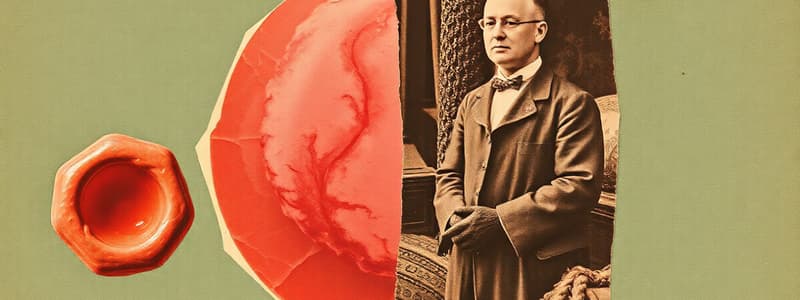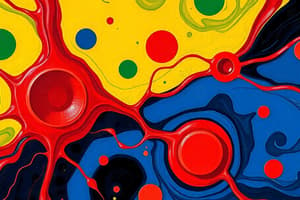Podcast
Questions and Answers
What is the initial trigger for under-activity of fibrinolysis?
What is the initial trigger for under-activity of fibrinolysis?
- Release of clotting factors
- External pressure on a wound
- Vascular endothelial damage (correct)
- Increase in platelet production
Which method is NOT commonly used to control haemorrhage in dentistry?
Which method is NOT commonly used to control haemorrhage in dentistry?
- Pressure application
- Sutures
- Cold compress (correct)
- Packing with haemostatic agents
How long should normal bleeding typically stop after a dental procedure?
How long should normal bleeding typically stop after a dental procedure?
- 1-2 minutes
- 30-60 minutes
- 10-30 minutes
- 4-10 minutes (correct)
What is one of the less commonly used methods for coagulating tissue in dentistry?
What is one of the less commonly used methods for coagulating tissue in dentistry?
Which aspect of haemostasis is particularly relevant to dental hygienists and therapists?
Which aspect of haemostasis is particularly relevant to dental hygienists and therapists?
What is the main function of adenosine diphosphate (ADP) in haemostasis?
What is the main function of adenosine diphosphate (ADP) in haemostasis?
In which condition is bleeding time likely to be prolonged?
In which condition is bleeding time likely to be prolonged?
What triggers the extrinsic pathway in the coagulation process?
What triggers the extrinsic pathway in the coagulation process?
What is the normal value range for Prothrombin Time (PT)?
What is the normal value range for Prothrombin Time (PT)?
Which factor is activated first in the intrinsic pathway of coagulation?
Which factor is activated first in the intrinsic pathway of coagulation?
What is the primary function of haemostasis?
What is the primary function of haemostasis?
Which stage of haemostasis involves the constriction of blood vessels?
Which stage of haemostasis involves the constriction of blood vessels?
Which substance is released by platelets to aid in their aggregation during primary haemostasis?
Which substance is released by platelets to aid in their aggregation during primary haemostasis?
What is the significance of von Willebrand factor in primary haemostasis?
What is the significance of von Willebrand factor in primary haemostasis?
Which of the following is a consequence of severe blood loss?
Which of the following is a consequence of severe blood loss?
In secondary haemostasis, what primarily forms the blood clot?
In secondary haemostasis, what primarily forms the blood clot?
Which symptom is NOT associated with moderate blood loss?
Which symptom is NOT associated with moderate blood loss?
What role do vasoconstrictors like endothelins play in haemostasis?
What role do vasoconstrictors like endothelins play in haemostasis?
What is the normal value range for Activated Partial Thromboplastin Time (aPTT)?
What is the normal value range for Activated Partial Thromboplastin Time (aPTT)?
Which factors are associated with inherited disorders such as Hemophilia?
Which factors are associated with inherited disorders such as Hemophilia?
Which drug is commonly used as an anticoagulant for preventing stroke?
Which drug is commonly used as an anticoagulant for preventing stroke?
What role does thrombin play in coagulation?
What role does thrombin play in coagulation?
What is a major effect of anticoagulants on the coagulation cascade?
What is a major effect of anticoagulants on the coagulation cascade?
What occurs during clot retraction?
What occurs during clot retraction?
Which condition can lead to depressed fibrinolysis?
Which condition can lead to depressed fibrinolysis?
What is the primary cause of thrombosis?
What is the primary cause of thrombosis?
Flashcards
Trigger for under-activity of fibrinolysis?
Trigger for under-activity of fibrinolysis?
Damage to blood vessel lining initiates reduced fibrinolysis.
ADP function in haemostasis?
ADP function in haemostasis?
Actively attracts more platelets to an injury site.
Extrinsic pathway trigger?
Extrinsic pathway trigger?
Tissue factor release initiates the extrinsic pathway.
Normal Prothrombin Time (PT)?
Normal Prothrombin Time (PT)?
Signup and view all the flashcards
Primary function of haemostasis?
Primary function of haemostasis?
Signup and view all the flashcards
Haemostasis: Vasoconstriction?
Haemostasis: Vasoconstriction?
Signup and view all the flashcards
von Willebrand factor significance?
von Willebrand factor significance?
Signup and view all the flashcards
Blood clot in secondary haemostasis?
Blood clot in secondary haemostasis?
Signup and view all the flashcards
Vasoconstrictors' role in haemostasis?
Vasoconstrictors' role in haemostasis?
Signup and view all the flashcards
Normal aPTT value?
Normal aPTT value?
Signup and view all the flashcards
Factors in Hemophilia?
Factors in Hemophilia?
Signup and view all the flashcards
Role of thrombin in coagulation?
Role of thrombin in coagulation?
Signup and view all the flashcards
Major effect of anticoagulants?
Major effect of anticoagulants?
Signup and view all the flashcards
What occurs during clot retraction?
What occurs during clot retraction?
Signup and view all the flashcards
Condition leading to depressed fibrinolysis?
Condition leading to depressed fibrinolysis?
Signup and view all the flashcards
Primary cause of thrombosis?
Primary cause of thrombosis?
Signup and view all the flashcards
Prolonged bleeding in?
Prolonged bleeding in?
Signup and view all the flashcards
Bleeding stops after procedure?
Bleeding stops after procedure?
Signup and view all the flashcards
Function of adenosine diphosphate?
Function of adenosine diphosphate?
Signup and view all the flashcards
Intrinsic pathway: Factor first?
Intrinsic pathway: Factor first?
Signup and view all the flashcards
Platelets release?
Platelets release?
Signup and view all the flashcards
Consequence of blood loss?
Consequence of blood loss?
Signup and view all the flashcards
Blood loss symptom?
Blood loss symptom?
Signup and view all the flashcards
Drug for preventing stroke?
Drug for preventing stroke?
Signup and view all the flashcards
Less common coagulation method?
Less common coagulation method?
Signup and view all the flashcards
Relevant haemostasis?
Relevant haemostasis?
Signup and view all the flashcards
Study Notes
Haemostasis
- Haemostasis is the process of stopping bleeding
- Process involves vasoconstriction, platelet plug formation, and coagulation
Primary Haemostasis
- Primary haemostasis includes vasoconstriction and platelet plug formation
- Platelets stick to damaged blood vessel walls and release serotonin and thromboxanes
Secondary Haemostasis
- Secondary haemostasis involves the formation of a stable fibrin mesh
- The clotting cascade activates factors to form fibrin from fibrinogen
- Fibrin mesh traps red and white blood cells
Clotting Cascade
- The clotting cascade involves a series of enzymatic reactions that lead to the formation of fibrin
- The extrinsic pathway is initiated by tissue factor, released from damaged endothelial cells
- The intrinsic pathway is triggered by collagen exposed in the blood vessel wall due to damage
- Both pathways lead to the formation of a common pathway that ultimately leads to fibrin
Coagulation Factors
- Most coagulation factors are synthesized in the liver
- Vitamin K is essential for the formation of clotting factors in the liver
Clot Retraction
- Clot retraction is the shrinking of the clot within 24 hours.
- Actin and myosin proteins within activated platelets pull the clot tight
Fibrinolysis
- Fibrinolysis is the process of breaking down the clot through the activation of plasminogen to plasmin
- Thrombin-activated fibrinolysis inhibitor (TAFI) is a fibrinolysis inhibitor that helps stabilize clots
Thrombosis
- Thrombosis is the formation of a blood clot inside a blood vessel
- Thrombosis can be caused by over-activity of coagulation, under-activity of fibrinolysis, or both
Studying That Suits You
Use AI to generate personalized quizzes and flashcards to suit your learning preferences.



